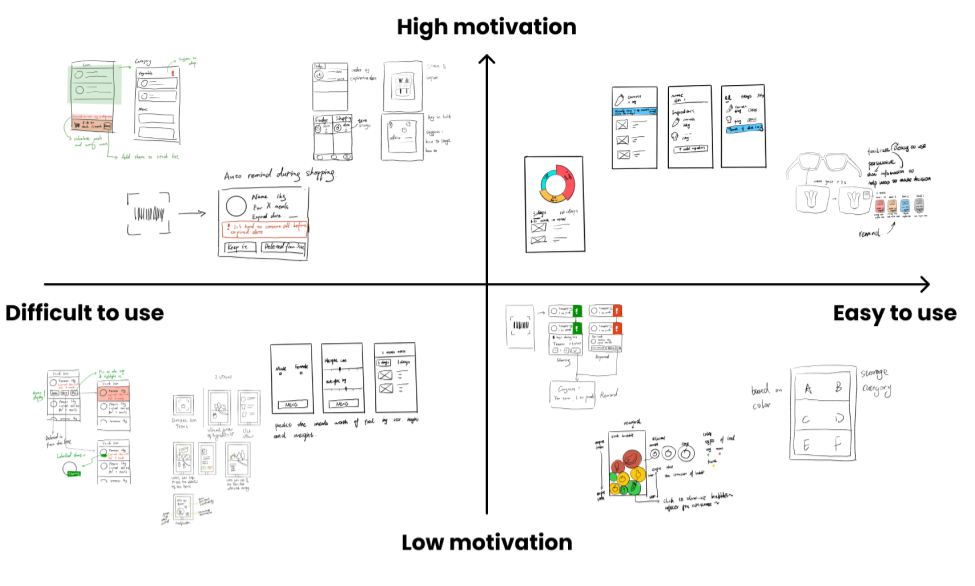Sustainability
Foodible
Foodible is an inventory management app that helps users track perishable food items to reduce waste. The mobile app acts as a live database to map food items and share food with the community. I led user research and usability testing to empower users to monitor their food inventory efficiently.
Role
Duration
User research, testing3 monthsSo what’s it all about?
About 13 million tonnes of food goes to waste in the UK each year. Foodible nudges people to keep a track of perishable items, update their inventory using AR, and make sustainable choices by monitoring their carbon footprint.
Here’s a video the covers it all.
Ideation
Alex shares a kitchen with four flatmates in student housing.
All four flatmates have an understanding about having one shelf in their shared communal fridge. Unfortunately, his food ends up getting moved around without his knowledge or pushed to the back when others stock their food in his shelf.
So, he loses track of his inventory, and ends up either:
throwing away food past expiration date or
bulk buying unnecessary items while shopping
So, how might we reduce food waste by helping people track their food in a communal kitchen?
User Research
Goals
Discover the decision-making processes of people while buying food.
Identify pain points of sharing a kitchen with multiple people.
Understand the limitations and adoption barriers of existing food tracking system.
Specifying target audience
Professionals and students living independently in flat sharing
Methods used
Survey (35 participants) + Semi-structured interviews (6 participants) + Competitor audit
Key insights
People buy more because they often don’t remember what is in their fridge!
Memory lapses often lead to overbuying, while boredom with existing food can also cause over buying.
Lack of clear organisation system in communal fridges makes it harder to keep track of items
Without clear labelling and storage systems, food items get misplaces and forgotten. This causes confusion, frustration and ultimately, food waste.
Existing food tracker apps are passive listing tools with tedious input and no feedback.
Current solutions require users to input manually data without providing any useful feedback about expiry date.
Design Process
Drawing up personas
Crazy 8s
Prioritisation matrix
Solutions that were too costly, bulky, difficult for communal use were weeded out.Two main design scenarios were finalised:reminding the users of their existing stocknotifying users of expiry date to consume.
(illustration by Suizi)
Low fidelity prototypes
High fidelity prototypes
Usability Testing
I asked participants to think aloud and conducted a focus group session. The inclusion criteria were people independently and a sharing fridge with at least 3 people.
Users tested with high fidelity prototype of the app through two scenarios:
The user added new food items to the inventory using scanner for QR codes and smart glasses.
The user had to either share, dismiss or consume food items.
Key insights based on the feedback:
Ambiguity in food status
Issue: Users were confused about whether items in the app were consumed or expired due to unclear labelling.
Opportunity: Implement a clearer visual system with distinct labels or icons to differentiate between "Consumed" and "Expired" items. Additionally, use colour coding or status indicators to quickly convey the state of each item.
Improving prioritisation of items expiring
Issue: Participants expressed a strong preference for sorting items by expiration date, with those expiring soonest appearing at the top.
Opportunity: Default the item list to sort based on the time left until expiration (in descending order). Allow users to customise sorting options for flexibility, ensuring a more intuitive food management experience.Lack of relatability in carbon footprint metrics
Issue: Users found the carbon dioxide emission figures abstract and unrelatable, which reduced their motivation to adopt sustainable behaviors.
Opportunity: Introduce a more relatable metric for measuring environmental impact, such as equivalent car miles driven, trees planted, or days of household energy usage saved. This could encourage users to make more sustainable food choices by providing tangible, easy-to-understand feedback.
Final solution
Real-time inventory tracking while shopping
Users can seamlessly scan items using smart glasses or their phone’s camera. The app automatically syncs items with the existing inventory and tracks their expiry dates.Why is it important? Prevents overbuying by alerting users if an item already exists in their fridge, reducing food waste and saving money.
User Flow:
Scan Item: Users scan products while shopping.
Real-Time Sync: The app checks the inventory and notifies if the item is already in stock.
Expiry Tracking: Newly scanned items are added to the inventory with automatic expiry date reminders.
Enhanced stock management
Users can tag food items for immediate use, set reminders, or share them with others to reduce waste.Why is it important? Promotes smarter food management by reminding users to consume perishable items before they spoil.
User Flow:
Tag items: Upon scanning, users can tag items as “Consume Soon,” “Remind Me Later,” or “Share with Friends.”
Timely reminders: The app sends push notifications to remind users of items nearing expiry.
Track environmental impact and compete on sustainability
Users can track how their choices contribute to environment by calculating the number of trees saved from reducing food waste.Why is it important? Engages users with gamification elements like leaderboard, encouraging them to make greener choices.
User Flow:
Carbon savings dashboard: Centralised carbon footprint tracking and competing with fellow app users on sustainability rankings.
Share perishable food: Users can simply set up food-sharing through existing apps (like WhatsApp, Olio etc.) to share with others who might need it.










